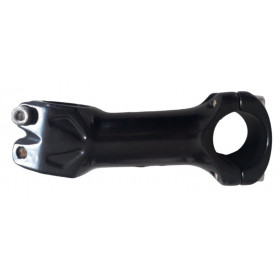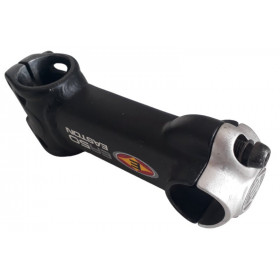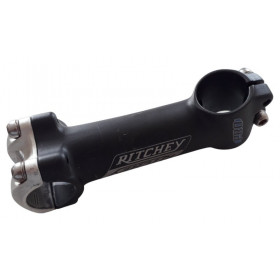-
 UsedBicycle stem 110 mm OS
UsedBicycle stem 110 mm OS- €8.99
-
 UsedEaston EA50 road bike stem 100 mm
UsedEaston EA50 road bike stem 100 mm- €14.00
-
 Used110 mm stem Ritchey PRO
Used110 mm stem Ritchey PRO- €9.99
Showing 1-3 of 3 item(s)
The old bicycle stem is an emblematic component of vintage cycles, recognizable by its retro aesthetic, its robust materials and its crucial role in the direction and posture of the cyclist. It is one of the old bicycle parts which is designed to integrate with period handlebars, it reflects the artisanal know-how of the manufacturers.
1. Types of stems for old bicycles:
a. Quill Stem
Main feature: A dip tube inserted directly into the fork pivot.Fixing system: Equipped with an expander or a wedge that widens to securely fix the stem.
Usage: Frequently used on vintage road, city and racing bikes.
b. Adjustable Stem
Design: Allows you to adjust the angle or height for better comfort.Usage: Often seen on old city or touring bikes, promoting a more upright position.
c. Integrated Stem
Design: Made in one piece with the handlebars.Usage: Common on specific-use bikes such as track bikes or certain entry-level models.
2. Materials and finishes of an old bicycle stem:
a. Chrome Steel
Advantages: Very robust and resistant to corrosion thanks to the chrome treatment.Aesthetics: Shiny surface, typical of high-end old bikes.
Weight: Heavier than modern materials, but perfectly suited to vintage bikes.
b. Aluminum Alloy
Advantages: Lighter than steel, while remaining robust enough for the constraints of vintage roads.Aesthetics: Matte or polished finish for a refined style.
c. Brass or Copper (decorative details)
Use: On high-end or artisanal stems to add an elegant touch.3. Dimensions and compatibility of an old bicycle stem:
a. Fixing Diameter
Fork Steerer: Typically designed for 22.2mm steerers (standard for older bikes).Handlebar Diameter: Varies between 25.4 mm (city bikes) and 26 mm (racing bikes).
b. Length
Old stems are often shorter than modern models, between 50 mm and 110 mm, adapted to the more compact frames of the time.c. Corner
Generally between 70° and 90°, influencing the height of the handlebars and the cyclist's posture.
4. Design and aesthetics of an old bicycle stem:
a. Minimalism
Older stems are designed to be discreet and leave the spotlight to the frame and handlebars.b. Engravings and Logos
Prestigious brands often engrave their logo or designs on the stem to assert their authenticity (example: Cinelli or T.A.).
c. Visible screws
Stem stems often feature a single, visible screw on top that is both functional and aesthetic.5. Reference brands of old bicycle stem :
a. Cinelli (Italy)
Known for its steel and aluminum stems, combining timeless design and artisanal quality.Famous Model: Cinelli 1A, emblematic of vintage racing bikes.
b. Philippe (France)
Specializing in high-end components for road and city bikes.Chrome materials and careful finishes.
c. T.A. (France)
Manufacturer renowned for its lightweight polished aluminum stems and accessories, very popular on old racing bikes.d. GB (Great Britain)
Known for its chrome steel and aluminum stems, used on Raleigh bikes or other British bikes.
6. Maintenance and Installation
a. Maintenance
Cleaning: Use a soft cloth and a non-abrasive product to maintain the shine of the chrome or aluminum.Protection: Apply a thin layer of wax or oil to prevent corrosion.
b. Facility
Insertion into Pivot: Apply light lubrication to the dip tube to aid installation.
Alignment: Make sure the handlebars are aligned with the front wheel before tightening the screw.
Conclusion :
The old bicycle stem is an essential element for preserving the authenticity and elegance of retro cycles. Combining quality materials, timeless design and practicality, it allows you to personalize the posture and style of the bike. Ideal for restoration enthusiasts or vintage enthusiasts, it guarantees a touch of originality to each old bike.
